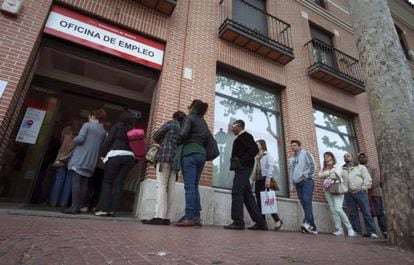Spain starts creating jobs again
Second quarter results show first rise in year-on-year net employment since onset of crisis in 2008

After six years, the Spanish economy is adding jobs again. The number of people in employment rose by 192,400 in the second quarter of the year from the same period in 2013, according to the Active Population Survey released on Thursday by the National Statistics Institute (INE).
This is the first time since the second quarter of 2008, just before the crisis, that net employment has grown, measured as growth from the previous year.
Meanwhile, unemployment also fell by 424,500 people to a rate of 24.47%.
“I’ve been waiting a very long time, ever since I arrived in La Moncloa, to be able to announce this kind of news. Our efforts are being rewarded,” said Prime Minister Mariano Rajoy of the Popular Party (PP).
I’ve been waiting a very long time, ever since I arrived in La Moncloa, to be able to announce this kind of news” Prime Minister Mariano Rajoy
“The labor market has performed a U-turn,” added Rajoy, who sought to tie the news to his own controversial labor reforms. “When we approved labor reform, unemployment was growing at an annual pace of 12%. Now it is dropping at a rate of 7%.”
Households where all members are unemployed also dropped by 7.3%, representing 1.83 million families, the INE said.
The figures add to a recent announcement by the Bank of Spain about sustained, if weak, GDP growth.
Annual statistics confirm the theory that increased job precariousness in recent years and cheaper firings means Spain no longer needs to grow at the same speed in order to create jobs again. Until the crisis hit, this growth rate was set at 2%, but on Thursday the Bank of Spain estimated it at 1.1%.
Unemployment also fell by 424,500 to a rate of 24.47%
The net increase of nearly 200,000 new jobs in the last year can be explained by wage devaluation, part-time work, seasonal hiring, subpar contracts and cheaper firings as a result of labor reforms.
Statistics also show that the workforce – people who have a job or are actively looking for one – grew by 92,000 in three months.
Broken down by sector, services was the only one where the employment rate grew, while it fell in construction, industry and agriculture. The private sector created jobs while the public sector continued to shed them.
In seasonally adjusted data, employment grew 1.03% in the last quarter and unemployment fell 3.12%.










































